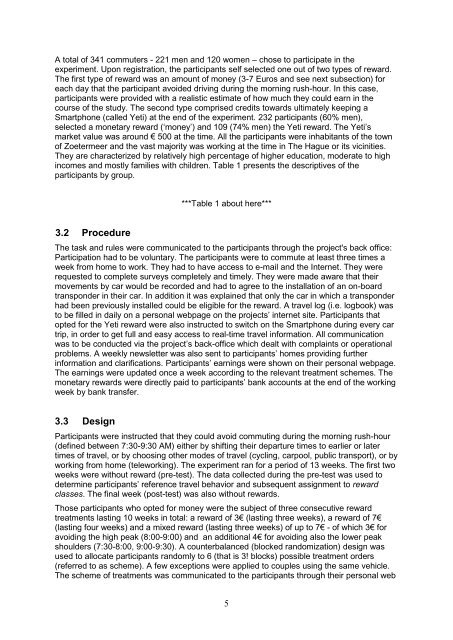Ben-Elia, E. and Ettema, D. (2011) Changing commuters' behav- ior ...
Ben-Elia, E. and Ettema, D. (2011) Changing commuters' behav- ior ...
Ben-Elia, E. and Ettema, D. (2011) Changing commuters' behav- ior ...
Create successful ePaper yourself
Turn your PDF publications into a flip-book with our unique Google optimized e-Paper software.
A total of 341 commuters - 221 men <strong>and</strong> 120 women – chose to participate in the<br />
experiment. Upon registration, the participants self selected one out of two types of reward.<br />
The first type of reward was an amount of money (3-7 Euros <strong>and</strong> see next subsection) for<br />
each day that the participant avoided driving during the morning rush-hour. In this case,<br />
participants were provided with a realistic estimate of how much they could earn in the<br />
course of the study. The second type comprised credits towards ultimately keeping a<br />
Smartphone (called Yeti) at the end of the experiment. 232 participants (60% men),<br />
selected a monetary reward (‘money’) <strong>and</strong> 109 (74% men) the Yeti reward. The Yeti’s<br />
market value was around € 500 at the time. All the participants were inhabitants of the town<br />
of Zoetermeer <strong>and</strong> the vast majority was working at the time in The Hague or its vicinities.<br />
They are characterized by relatively high percentage of higher education, moderate to high<br />
incomes <strong>and</strong> mostly families with children. Table 1 presents the descriptives of the<br />
participants by group.<br />
3.2 Procedure<br />
***Table 1 about here***<br />
The task <strong>and</strong> rules were communicated to the participants through the project's back office:<br />
Participation had to be voluntary. The participants were to commute at least three times a<br />
week from home to work. They had to have access to e-mail <strong>and</strong> the Internet. They were<br />
requested to complete surveys completely <strong>and</strong> timely. They were made aware that their<br />
movements by car would be recorded <strong>and</strong> had to agree to the installation of an on-board<br />
transponder in their car. In addition it was explained that only the car in which a transponder<br />
had been previously installed could be eligible for the reward. A travel log (i.e. logbook) was<br />
to be filled in daily on a personal webpage on the projects’ internet site. Participants that<br />
opted for the Yeti reward were also instructed to switch on the Smartphone during every car<br />
trip, in order to get full <strong>and</strong> easy access to real-time travel information. All communication<br />
was to be conducted via the project’s back-office which dealt with complaints or operational<br />
problems. A weekly newsletter was also sent to participants’ homes providing further<br />
information <strong>and</strong> clarifications. Participants’ earnings were shown on their personal webpage.<br />
The earnings were updated once a week according to the relevant treatment schemes. The<br />
monetary rewards were directly paid to participants’ bank accounts at the end of the working<br />
week by bank transfer.<br />
3.3 Design<br />
Participants were instructed that they could avoid commuting during the morning rush-hour<br />
(defined between 7:30-9:30 AM) either by shifting their departure times to earlier or later<br />
times of travel, or by choosing other modes of travel (cycling, carpool, public transport), or by<br />
working from home (teleworking). The experiment ran for a period of 13 weeks. The first two<br />
weeks were without reward (pre-test). The data collected during the pre-test was used to<br />
determine participants’ reference travel <strong>behav</strong><strong>ior</strong> <strong>and</strong> subsequent assignment to reward<br />
classes. The final week (post-test) was also without rewards.<br />
Those participants who opted for money were the subject of three consecutive reward<br />
treatments lasting 10 weeks in total: a reward of 3€ (lasting three weeks), a reward of 7€<br />
(lasting four weeks) <strong>and</strong> a mixed reward (lasting three weeks) of up to 7€ - of which 3€ for<br />
avoiding the high peak (8:00-9:00) <strong>and</strong> an additional 4€ for avoiding also the lower peak<br />
shoulders (7:30-8:00, 9:00-9:30). A counterbalanced (blocked r<strong>and</strong>omization) design was<br />
used to allocate participants r<strong>and</strong>omly to 6 (that is 3! blocks) possible treatment orders<br />
(referred to as scheme). A few exceptions were applied to couples using the same vehicle.<br />
The scheme of treatments was communicated to the participants through their personal web<br />
5

















